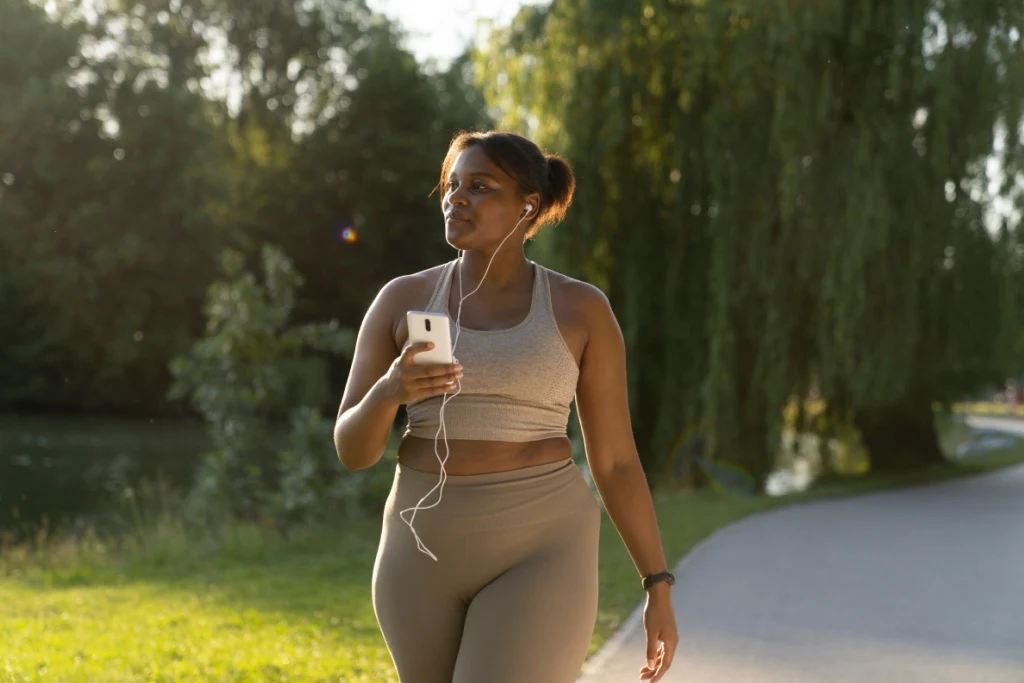Does Walking Build Muscle?
Walking offers a long list of benefits, but is muscle-building on that list?

October 31, 2024 - Updated October 31, 2024

The Sweat trainers are all huge fans of walking - and for good reason. Getting your step count up won’t cost you a cent, doesn’t require any equipment, and you don’t need a high level of strength or fitness to get started. Walking also offers a huge variety of health benefits, improving your cardiovascular fitness, mood and blood pressure, reducing your risk for chronic disease, plus all the added benefits of spending time in nature if you can take your walk outdoors. But does muscle-building have a place on that list? Here’s what you need to know.
If your goal is to build strength and muscle…
While walking obviously engages your muscles and can improve muscular endurance and tone, walking alone is not going to lead to significant muscle gains. To build strength and muscle, you’ll want to follow a structured strength training program designed to elicit hypertrophy and the results you want by putting enough strain on your muscles. That isn’t to say that walking does nothing for your muscles, it’s just not the best training style to help you achieve these goals.
A small study from 2018 aimed to investigate the effects of a 10-week walking program, with a group of 64 inactive participants over the age of 65 following a walking-only plan or a program that combined walking with resistance training. Although both groups showed improvements in muscle size, unsurprisingly, the group whose exercise program included resistance training showed greater improvement.
However, you don’t have to choose between the two! If you’re following a strength training program, this doesn’t mean walking has no place in your fitness routine. Walking is an amazing way to keep your body moving between training sessions, improve your cardio fitness, boost muscle recovery, endurance and tone, maintain a healthy weight, and throw in some variety! Sweat’s head trainer Kayla Itsines has always included treadmill walks in her weekly routine to complement her resistance workouts.

If you’re just starting out…
For fitness beginners or those coming back from a break, walking is a fantastic way to kickstart your training routine and the benefits of walking tend to be far more noticeable if you’re new to exercise than if you’ve been working out for years. You can start gently, build to a brisk or incline walk, and feel your fitness and muscular endurance quickly improve.
After an intense walk, you may even notice aches or a fatigued feeling in your calves, quads, hip flexors, hamstrings or glutes.
If you get to a point where walking no longer offers enough of a challenge and you want to take things up a notch, your base fitness level will be at a great place to start a workout program or turn your walk into a jog.
If you want to make your walks more challenging…
A walk doesn’t have to mean a relaxed stroll - this form of exercise can definitely get your heart rate up and your muscles burning. The key is to look for ways to challenge your body and increase the intensity. Ready to take your walk to the next level, why not try…
Walking up hills or stairs or increasing the incline if you’re on a treadmill. This will will add more of a challenge for your calves, glutes, hamstrings and quads (and cardiovascular system!)
Carry small dumbbells or wear a weighted vest, ankle or wrist weights to increase the resistance
Increase your speed to a power walk or do speed-walking intervals, this can also mean moving your arms more and getting your upper body involved!
Walk on uneven terrain to challenge the smaller stabiliser muscles in your lower body as well as your core
Building your cardiovascular fitness and muscular endurance by increasing the intensity of your walks can also improve your overall athletic performance in your other workouts. Even the increased circulation can be a great way to speed up your recovery and have you ready for your next session by promoting blood flow to your muscles.
Walk your way to good health
There is so much to be gained by including walking in your fitness routine, regardless of whether building muscle is a goal of yours or not, and most Sweat programs include at least one weekly session of low-intensity steady state cardio so you can reap the benefits. And if you’re ready to start your strength training journey, we’ve got you covered with a huge range of programs perfect for training in the gym or at home.

Erin is a writer and editor at Sweat with years of experience in women's publishing, the fitness industry, media and tech. She's passionate about the power of movement, and you can often find her on a yoga mat, a hike, a dance floor, in the ocean or the gym.
* Disclaimer: This blog post is not intended to replace the advice of a medical professional. The above information should not be used to diagnose, treat, or prevent any disease or medical condition. Please consult your doctor before making any changes to your diet, sleep methods, daily activity, or fitness routine. Sweat assumes no responsibility for any personal injury or damage sustained by any recommendations, opinions, or advice given in this article.
Fitness